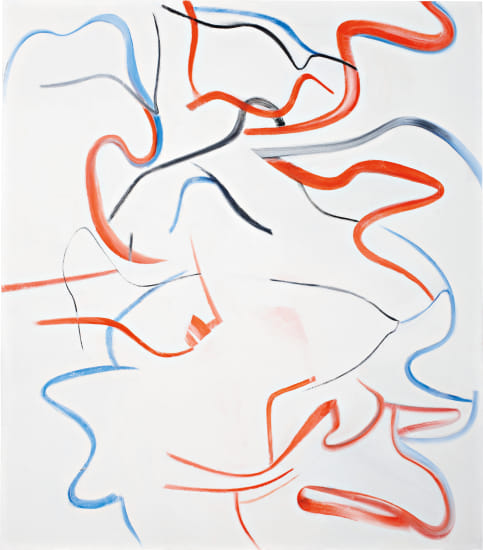To loosen the grip the seemingly inevitable has on us begins our journey to make our way in the world. View the study sheet here. Watch the recording here.

Jazz music. The Wild West. And Walt Whitman. This collage of unleashed exuberance, mythic unbridled freedom, and robust song of democracy drew Willem de Kooning, an impoverished 22-year old artist to America. Raised by a single mother who ran a bar in Rotterdam in the Netherlands, de Kooning stowed away in 1926 on the British freighter Shelley bound for Argentina. At Virginia, he slipped off the ship, illegally entered the United States and eventually made his way to New Jersey, where he worked as a house painter before finding his way to the art scene in New York.
In his short poem “America,” Whitman sang praise of this country as Strong, ample, fair, enduring, capable, rich/A grand, sane, towering, seated Mother/Chair’d in the adamant of Time. America was “chair’d in the adamant of Time” because it had defied the European fate of being a captive to the past. For Whitman, the uniquely democratic nature of America would enable it to constantly reinvent itself. This ability to be in a state of permanent, popular re-imagining ensured that, among all nations, it would endure.
De Kooning embraced this Whitmanian ethos of constant re-visioning. He formed a core group of artists for whom the critic Harold Rosenberg coined the term “action painting.” This described the work of artists for whom the canvass was “an arena in which to act” rather than as a place to produce a product. Their paintings were events, encounters between the artist and the materials, rather than finished works.
Rosenberg in particular highlighted the ever unfinished work of de Kooning as examples of this defiance of the finality of time. De Kooning was constantly reworking, reconfiguring his pieces. About them Rosenberg noted that most of the compositions for which de Kooning was famous were actually “powerful middles, without beginnings or ends.” The only finality about them, he observed, involved the act of transporting them from the studio to the gallery for hanging.
Without a conventional beginning or a conventional ending but with a powerful middle describes well the Torah and the vista it describes. With Exodus and the awakening of the Israelite nation to their mission, there is a profound shift in how Torah introduces God. At the burning bush Moses is instructed to call God Ehyeh Asher Ehyeh, “I am becoming that which I am becoming.”
In this week’s portion, God informs Moses that God had appeared to Moses’ ancestors as El Shaddai (a noun ) but had not appeared to them as Yud Hei Vav Hei (letters constituting a form of the verb “to be”.) The Israelites need to hear that God is not a clarified and static noun but a verb, dynamic and evolving. Torah becomes here more action painting than representation of what is fixed and limited in its dimensions and function.
Pharaoh as antagonist to this call of liberation from the constraint of the way things are rails against the Israelites as “shirkers.” They subvert the culture of oppression, according to a midrash, by engaging in reverie and play. They share with one another their dreams, whispered tales of a sacred promise of deliverance. They nourish one another with imaginings of an alternative future. The more they give voice to such possibilities, the more they see themselves as aligned not with a god of place or object but with a God of “becoming.”
Pictured here is de Kooning’s Untitled XVIII. It was painted late in his career, in 1984. Although one of the founders of Abstract Expressionism, de Kooning never completely abandoned the human figure as essential to the making of art. Clement Greenberg, the primary art critic promoting Abstract Expressionism as the highest form of painting, interrogated de Kooning about whether a truly modern artist could justify figurative painting. “In today’s world,” Greenberg pronounced, “it’s impossible to paint a face.” “That’s right,” replied de Kooning, “and it’s impossible not to.”
De Kooning was enamored with the playfulness and colorful exuberance expressed by Matisse on his canvasses. In Untitled XVIII one can imagine Matisse’s dancers, in their circle with their arms extended, embracing one another and ecstatic in their joyful abandon and freedom. There is a dynamic at work here that refuses definition while still celebrating human presence.
De Kooning’s disregard for the division between abstract and figuration would eventually inspire others to break the ideological hold of Abstract Expressionism on the art world. Artists such as Larry Rivers and Grace Hartigan would, often in the face of criticism from their contemporaries, reimagine figurative painting and restore it to a new place of prominence in art. Their innovations honored de Kooning’s observation, “You have to change to stay the same.”
In the opening chapters of Exodus the Israelites begin to stir out of hundreds of years of enslavement. Change is not only possible, they recognize; it is the essence of life. Not only for creating a future but also for preserving the past. And essential to it is a sense of reverie, imagination and play.
Join us here at 7:00 p.m. (PT) Thursday, January 11 as we explore the liberating power of reverie.








